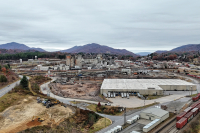New model for mountain living
Mixed-use developments where residents live, work, shop and dine within a few block radius are popping up in cities around the nation, but have been slower to take hold in the mountains of Western North Carolina. One Macon County developer is aiming to bring the concept of mixed use to the mountains by turning a 22-acre parcel of land near downtown Franklin into a community where cars are hardly needed and everyone knows your name.
When it’s all said and done, Sanctuary Village will feature 150 residences in a variety of styles, from single-family homes to condos to live-work spaces. The development will have its own store fronts, as well as access to a grocery store, restaurants and a hospital all within a half mile in greater downtown Franklin.
“This is an in-town, urban neighborhood, much denser than what people are used to in mountain communities,” said Ben Brown, spokesman for the development.
If this trend does take hold in the mountains, it could be good news for preserving the natural environment.
“This is all about spreading out the options,” Brown said. “If you have X number of people coming to the region looking for mountain housing options, the more people we can convince to live close in and pick up a smaller footprint per person, the better we are for saving agricultural land and mountain slope land.”
Sanctuary Village is a far cry from the archetypal mountain housing development, with a focus on lots of acreage and big views. Some of these typical developments offer limited interaction with the community around them.
“You’ve wound up with a lot of gated communities that have no draw other than living right in them,” said Franklin Town Planner Mike Gruberman.
Building a community
For those who intend to make the mountains their home, big, gated developments can be isolating — something Sanctuary Village developer Tim Ryan experienced firsthand. Several years ago, Ryan and his wife, Iva, left their day jobs in South Florida to live on a large, working farm in Macon County. The Ryans loved the drastic change of pace, but after a while, still felt something was missing.
“Here in the mountains, we all come here to connect to the environment,” Tim said. “But you really need to connect with other people as well.”
Tim envisioned a place where people live in close quarters with their neighbors and eat, work and shop in close proximity. The community model, known as new urbanism, espouses mixed-use development, and has grown in popularity in the last few years.
“It truly creates an opportunity for community, much more than throwing a bunch of houses together,” Tim said.
Sanctuary Village is in its first phase, and the house the Ryans reside in is the only one built so far in the development. But even from preliminary plans, it’s clear the community is anything but thrown together. The development will feature small cottages to large homes to condos ranging from 700 square feet to 3,000 square feet, each built with one of a dozen architectural styles that reflect the mountain environment.
Seniors will likely be a big market for Sanctuary Village.
“As people age, they may want to move closer to services but don’t want to leave Franklin,” said Iva Ryan. “They want to be in a community where neighbors know them and care about them.”
But like the housing choices, the population of Sanctuary Village and other mixed-use communities is often diverse.
“We’re finding these communities appeal to different ages, backgrounds, and interests of people who want to connect,” said Iva.
Connectivity is evident in the design of the development through things like shared open spaces.
“Common areas are an extension of the home,” said Iva. “You don’t want to get people stuck in a house, you want them to feel comfortable so they’ll engage.”
Mutual benefit
The concept of a traditional neighborhood development like Sanctuary Village has so rarely been proposed in the mountains that the town of Franklin had to adopt new zoning ordinances to accommodate it.
“The town had not had anything like this before,” Gruberman said. “This was our first shot at what is called a traditional neighborhood development, and there was a fairly lengthy process involved because it wound up creating a new zoning district.”
With the help of plenty of public input, the town created a new neighborhood development zoning category with unique specifications.
“Walkability was the chief issue,” Gruberman said. “The development must be a minimum number of acres and within a half mile walking distance of the downtown area. It’s intended to reduce dependence on cars.”
Pulling together enough property to create Sanctuary Village was a challenge, since most areas around small mountain downtowns are already built up. But Ryan finally managed to piece together several different parcels because he truly believed Franklin was the right place for the development.
“Franklin is a very easy community to live in,” Ryan said. “You can live here and not need a car.”
Downtown is a big selling point of the development, which makes for a beneficial partnership, said Brown.
“It’s really selling the town of Franklin as an amenity,” Brown said. “The better off the town is, the better of the development is. There’s a built in incentive for the town and developer to work together, and for the developer to support Main Street businesses and help strengthen Main Street opportunities.”
Catching on
Since new urbanism hasn’t been tested in the mountains, there’s no guarantee it will catch on with buyers. But Tim has one major advantage — Sanctuary Village provides an option that isn’t widely available in the seven counties west of Asheville.
“People are still going to want to live in suburban areas and on mountain tops, but in the current market there are way, way more mountain top lots and suburban options for people than there are in town options,” Brown said.
The speed at which Sanctuary Village is being developed has slowed in the wake of the economic downturn.
“We’re moving carefully — this is not a time that banks lend money to developers,” said Ryan.
But Ryan believes that when the economy picks back up, many people will emerge with different, simpler attitude toward life — and Sanctuary Village will be poised to attract them.
“(The economy) really has forced people to rethink priorities and get back to simpler, more sustainable approach to living,” said Ryan.
Brown said the Ryans are “heavily invested in the idea that these in-town, traditional neighborhood designs that are walkable, mixed-use communities will be the most desirable kind of project for people to buy into.”
Haywood commissioners asked for more oversight of mega-developments
A group of Haywood residents appealed to county commissioners for an ordinance assessing the impacts of large developments.
The ordinance would require large developers to assess the impacts of their projects on surrounding communities and the environment. On Monday night (Feb. 16), the group called Haywood Community Alliance presented the board of commissioners with signatures of nearly 400 county residents who support the idea.
“Such an asset review would provide local government and citizens with important information about anticipated effects on natural resources of the area, as well as existing infrastructure,” Lynn Jeffries, the group’s chair, told commissioners.
The board agreed to send the proposed ordinance to the planning board to review. The planning board could use that ordinance, or draft one of its own.
The request to commissioners marks the first time a group of citizens has formally asked them to take action on development. Recent regional planning projects, like the Mountain Landscapes Initiative or the Haywood Growth Readiness Roundtable, have emphasized the importance of local government involvement, but have stopped short of formally requesting that commissioners address the issue.
A year-long effort led up to Haywood Alliance’s request to the county. The group first showed commissioners an initial set of signatures they collected, but that generated little response from the board.
“We weren’t seeing any action; nothing moving forward,” Jeffries said.
But Jeffries says her group was convinced commissioners were interested in addressing growth and development. Last year, commissioners extended an invitation to various community clubs offering the county’s assistance with planning. The offer had no takers.
“We felt the commissioners last year had reached out to these clubs and said ‘okay, who wants to have this dialogue?’” Jeffries said. “So we felt they were already pursuing community input and trying to find a vehicle where community members could give input to commissioners.”
Jeffries said the issue got put on the backburner when election season rolled around, but that her group continued to engage in talks with the county to form a proposal and encourage commissioners to act.
She said that development issues have somewhat dropped from the radar as the economy has taken center stage, but that a period of slow development is an ideal time to address issues of growth.
“Let’s take this lull time as the perfect opportunity, when we won’t have any huge developments coming down the pike right this second,” Jeffries said.
Commissioners haven’t promised they will adopt the proposed ordinance — only that the county will take a look at it. The process may not be easy. Chairman Kirk Kirkpatrick said he is well aware, and supportive, of the deeply rooted sentiment of autonomy over your property that has made passing other planning initiatives in the region a challenge.
“I would look at (the ordinance) with a keen eye, simply because people around here have worked a long time for what they have,” Kirkpatrick said. “I do not want to see additional restrictions placed on those people who are private landowners.”
Jeffries said planning efforts don’t have to infringe on personal property rights, however.
“I do feel like that’s a challenge to getting this message across, but I don’t think it has to be,” she said. “I think you can find a consensus where we can exercise our personal property rights with the understanding that we live in a community, we don’t live in isolation. The things that we do affect our neighbors, and will affect our future.”
Development regs at issue in Jackson election
When Jackson County commissioners passed strict mountainside development regulations last year, opponents pledged to get even come election time.
Franklin adopts new rules for floodplain construction
By Jennifer Garlesky • Staff Writer
Macon County’s eight-month moratorium on the permitting of recreational vehicles in the floodplain will be lifted next month.
Ordinance changes could lift floodplain development ban
By Jennifer Garlesky • Staff Writer
Macon County residents will have the opportunity to weigh in on amendments to the county’s flood damage prevention and watershed ordinances at a public hearing on Feb. 11.
Youth get a hands-on look at planning their future
By Jennifer Garlesky • Staff Writer
Rachel Upchurch wants to protect the mountains that tower throughout Jackson County however; the Smokey Mountain Elementary student also wants to see more houses and shopping centers built throughout the Qualla community.
Rapp tries to round up support for slope development bill
When back-to-back tropical storms hit the mountains with heavy rains in 2004, the saturated soils triggered more than 140 landslides. Some were small, others big, but all pointed to how vulnerable some mountain slopes are to the forces of nature — namely gravity.
On Cataloochee Wilderness: Project spokesman Frank Singleton talks about fitting into the community and facing possible opposition
By Julia Merchant • Staff Writer
Frank Singleton, the spokesman for the 4,500-acre proposed Cataloochee Wilderness Resort in Haywood County, stopped by The Smoky Mountain News office to answer some questions about the planned development. Singleton said the ball is definitely rolling on the project, with announcements about retail operations set to come in the next few weeks and a public presentation planned for the end of January. He addressed public opposition to the project, the developers’ appearance at a county commissioners meeting on Dec. 17, and the involvement of Dean Moses, a Haywood County businessman notorious for questionable business dealings he made here six years ago.
2007: A year for development news
This year marked a turning point across Western North Carolina when it comes to political will and the development industry.
Mountain protections gained wide support in 2007
For those of us who have been beating the drum about the need for mountain communities to get serious about land-use planning, it’s been an eventful year. Not only was a lot of real progress made in 2007, but signs point to an even brighter future as many progressive candidates won seats on county and town boards throughout the region.









